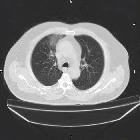strahleninduzierte Lungenerkrankung



Radiation-induced lung disease (RILD) is a frequent complication of radiotherapy to the chest for chest wall or intrathoracic malignancies and can have a variety of appearances, especially depending on when the patient is imaged. Acute and late phases are described, corresponding to radiation pneumonitis and radiation fibrosis, respectively. These occur at different times after completion of radiotherapy and have a different clinical presentation, imaging features, and differential diagnoses.
As such they are discussed separately:
The remainder of this article is a general discussion of the effects of radiation on the lung.
Epidemiology
The demographics of patients affected by radiation-induced lung disease are those of the underlying condition for which radiation therapy was performed. Typically patients have received radiation therapy for one of the following:
- lung cancer
- breast cancer
- mediastinal malignancies
- lower neck nodal disease
The risk of developing radiation-induced lung disease depends on a number of factors, including:
- total dose administered
- rare below 20 Gy
- almost invariable above 40 Gy
- degree of fractionation: a smaller number of fractions to deliver the total radiation dose
- prior chemotherapy
- actinomycin D
- adriamycin
- bleomycin
- busulfan
- concurrent chemotherapy
- smoking history
- reduced lung function
- pulmonary hypertension
See also
radiation induced organizing pneumonia (RIOP): different entity - a type of secondary organizing pneumonia that is characterized by infiltrative opacification "outside" the irradiated volume
radiation recall pneumonitis: rare reaction in previously irradiated area of pulmonary tissue after application of triggering agents (e.g. chemotherapeutic agents, immunomodultors etc.)
Siehe auch:
- Strahlenpneumonitis
- radiation induced pulmonary fibrosis
- Selektive interne Radiotherapie (SIRT)
- strahleninduziertes Lungenkarzinom
und weiter:

 Assoziationen und Differentialdiagnosen zu strahleninduzierte Lungenerkrankung:
Assoziationen und Differentialdiagnosen zu strahleninduzierte Lungenerkrankung:
